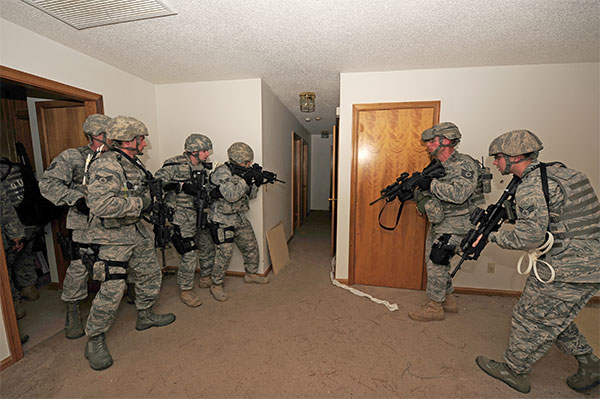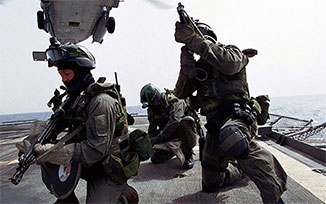U.S. Air Forces Emergency Services Team (EST)
U.S. Air Force Emergency Services Teams (EST) are special elements of USAF Security Forces Squadrons units that are capable of dealing with specialized threats at USAF installations. Depending on the installation in question, EST may instead by known as Special Emergency Response Team (SERT) , Quick Response Team (QRT) or Special Reaction Team (SRT).
Emergency Services Team - Role
Analogous to civilian special weapons and tactics (S.W.A.T.) teams, ESTs may be called on to intervene in a number of high risk scenarios at USAF installations:
- active shooter
(person or persons engaging on a shooting spree) - barricaded suspects
- hostage situation
- counter terrorism
- VIP protection
- high-risk arrests
- sniper incidents
- aircraft recapture
USAF ESTs are similar in role and training to USMC Special Reaction Teams and U.S. Army Special Reaction Teams.
Emergency Services Team - Organization & Equipment
Emergency Services Team members are typically drawn from the Security Forces Squadron stationed at a given USAF installation.
A typical EST is split into an entry / assault element and a marksman / observer element.
EST Entry elements are armed with M4 carbines and M9 Beretta pistols. Some may carry a 12-gauge shotgun. Protection for the entry team includes the use of ballistic shields. A range of equipment for forcing entry into buildings is available, including battering rams and Halligan bars (hooligan tool).
Shooters in the Marksman Observer elements are armed with the USAF variant of the M24 7.62mm bolt-action sniper rifle.
Emergency Services Team - Selection & Training
Airmen wishing to join an Emergency Services Team must undergo an initial series of tryouts which typically last 36 hours over 2 days. These tryouts include fitness tests, written exams and weapons qualifications.
ESTs require their members to undergo the U.S. Army's Advanced Law Enforcement Training Division (ALETD) Special Reaction Team Course at Fort Leonard Wood, Missouri. This consists of 2 phases of training:
- phase one for the entry elements teaches close quarters combat (CQC), building entry, breaching, repelling, hostage rescue etc.
- phase two is an additional week-long course for the marksman observer elements which focuses on advanced marksman training and tactics.
ESTs carry out regular refresher courses to keep their skills up to date.
Emergency Services Team Photos








